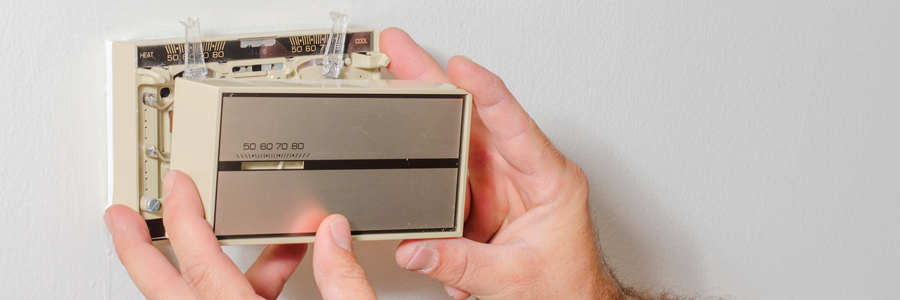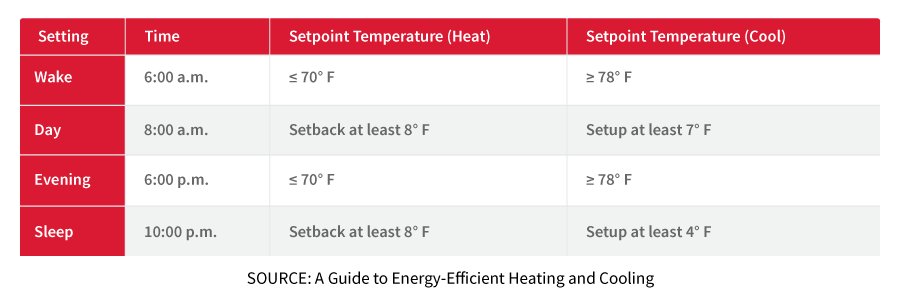
Not too long ago, homeowners like you had to adjust their indoor temperature by opening windows or fueling fires. Luckily, indoor temperature control has evolved. Today, it is hard to imagine a modern home without a device to set the desired indoor temperature.
Below highlights the differences between the basic, programmable and smart thermostat or control system for your heating and cooling system.
The Basic Thermostat
The basic thermostat is designed to turn on the central heating and cooling system at one temperature and off at another. A basic thermostat may offer homeowners three essential switches that include:
- A HEAT and COOL switch
- An ON, OFF or AUTO fan switch
- A means to increase or decrease the temperature settings
While these options provide critical heating and cooling system functionality, additional features may be required depending on your specific HVAC equipment. For example, a thermostat for a heat pump should include an option for auxiliary heat. The auxiliary heat switch activates the air handler’s (the most common inside component of a heat pump system) heat strips to turn on to supplement the output.
The Programmable Thermostat
The sophistication level of indoor temperature control was elevated with the introduction of the programmable thermostat. Although some early programmable thermostats could be challenging to program, newer models were designed to be more intuitive and easier to operate.
With the programmable thermostat, homeowners can align their temperature preferences with their lifestyle and schedules. Preprogramming temperatures can create an indoor environment that makes occupants most comfortable and potentially save homeowners money in the process. A programmable thermostat or control system can save you as much as $180 every year in energy costs when properly programmed.1
If you need assistance with determining setpoints times and temperatures, ENERGY STAR® suggests the following:2

The Smart Thermostat or Control System
Intelligent heating and cooling devices are becoming more commonly accepted as homeowners continue to look to technology to connect their smartphones, lives, and homes. The smart thermostat or control system designs may vary, but these devices may:3
- Provide the option of utilizing a smartphone or home automation device to control indoor temperature and humidity settings.
- Learn your temperature preferences and establish a schedule that automatically adjusts to energy-saving temperatures based this learned behavior.
- Know when you are on the way home based on the location of your smartphone and automatically adjust your home’s temperature to your liking.
- Enter a low-power standby mode when inactive.
In 2016, the Environmental Protection Agency (EPA) finalized the ENERGY STAR® specifications for smart thermostats. According to ENERGY STAR®, it was challenging to identify household thermostats that save energy because of the disparities of how an individual or family ultimately sets the temperature4 But Abi Daken, Program Manager for ENERGY STAR® HVAC products, said, “Anyone who cares about energy savings but is too busy to think about their heating and cooling use can be assured that these products have shown they help other busy families."5
When integrated with popular voice-controlled home automated devices, homeowners now have the option of even more sophisticated indoor temperature control than with previous programmable thermostats. For example, both the Amazon Echo and Google Home integrate with the Honeywell Total Connect Comfort App to provide advanced inter-connectivity and voice control ability.
Even without dedicated smart devices, homeowners may be able to control certain models of smart thermostats or control systems directly through their smartphone and/or tablet app. When a compatible smart thermostat or control system is installed, a coordinating app may be able to remotely monitor and manage home comfort, and possibly energy use anytime, anywhere.
In the near future, a thermostat or control system mounted on a home’s wall may not even be necessary. Advancements in technology may allow your heating and cooling system to communicate directly with your smart phone or app. The evolution of a home without a thermostat or control system may be just around the corner.

1 Thermostats. n.d. <https://energy.gov/energysaver/thermostats>.
2 "A Guide to Energy-Efficient Heating and Cooling." August 2009. Energy Star. <https://www.energystar.gov/ia/partners/publications/pubdocs/HeatingCoolingGuide%20FINAL_9-4-09.pdf>.
3 ENERGY STAR®. Certified Products. 2017. https://www.energystar.gov/products/smart_thermostats. 27 March 2017.
4, 5 U.S. Environmental Protection Agency. ENERGY STAR® Ends the Thermostat Wars by Introducing FIrst-Ever Smart Thermostat Specification. 1 March 2017. <https://www.energystar.gov/about/content/energy_star_ends_thermostat_wars_introducing_first_ever_smart_thermostat_specification>.